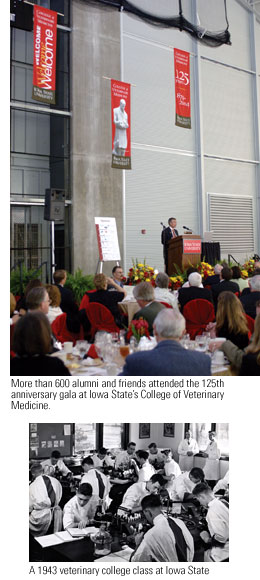Iowa State veterinary college celebrates 125 years
|
Alumni, faculty, students, and veterinary professionals were invited to attend the celebration, which included a Pet Care Seminar, College Pride Day, Veterinary Diagnostic Laboratory Day, and a building project informational meeting. The event concluded with a banquet on Saturday. During the celebration, the Ames, Iowa-based college reflected on events that surrounded its inception in 1879. At that time, hog cholera was one of the more prevalent, devastating diseases threatening the fledgling livestock industry. Initially, veterinary professionals believed bacteria caused the disease. But vaccine development in 1905 by veterinarians from Iowa State and the Department of Agriculture Hog Cholera Research Station helped prove that the disease was viral. The discovery led to a vaccine that made substantial advances in the control of the disease. The college continues to focus its efforts on livestock disease eradication. "The visionaries who established the college recognized the importance of veterinary medicine to the livestock industry and to the safety of the food supply," said Dr. John U. Thomson, dean of the College of Veterinary Medicine. Iowa State has made numerous contributions to production animal medicine. Highlights include the identification of a new subtype of swine influenza virus (SIV H3N2) in 1998 by college faculty members Drs. Kyoung-Jin Yoon and Bruce H. Janke. This was the first subtype detected since the disease was discovered in the United States. Also, in 1997, Dr. Pat G. Halbur and collaborators discovered the first animal virus strain of hepatitis E. Identification of the novel virus, which was designated as swine hepatitis E, was determined to be different from the human virus and opened new avenues of research. Research by Dr. Richard F. Ross in the 1970s helped reduce the severity of a disease that caused lactational failure in sows, which saved U.S. pork producers an estimated $37 million annually. In the 1960s and 1970s, Dr. M. S. Hofstad developed vaccines and diagnostic control methods for infectious bronchitis in chickens. The research saved poultry producers an estimated $80 million annually. Finally, in the 1950s and 1960s, Dr. William P. Switzer determined the causes of atrophic rhinitis in swine. He also isolated the cause for one form of pneumonia in swine. The research led to methods that saved U.S. pork producers an estimated $60 million annually. | ||
 Iowa State University College of Veterinary Medicine turned 125 years old in 2004 and, to mark the occasion, hosted an anniversary celebration on April 25-30.
Iowa State University College of Veterinary Medicine turned 125 years old in 2004 and, to mark the occasion, hosted an anniversary celebration on April 25-30.